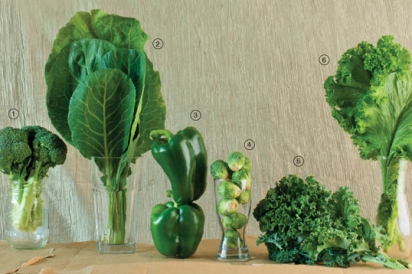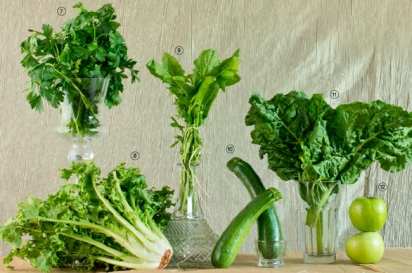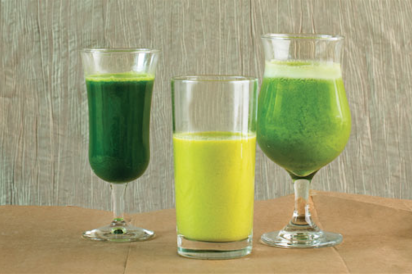Turn Over a New Leaf: Green Superfoods
If your diet is lacking in color, look no further than this roundup of gorgeous green foods. We’ve picked leafy, cruciferous, and even, fruity varieties. Start with these super foods and the accompanying collection of super-easy ways to cook them. Ready, set, go green!
1) BROCCOLI: Keep it simple, and steam or blanch this cruciferous crop, filled with vitamins C and A, potassium, and folate, which helps enhance vital nerve function and the production of DNA, says Rae Ivory, café supervisor at the East End Food Co-op. Top it off with a squeeze of lemon, salt, pepper, and a quick shaving of Parmesan cheese.
2) COLLARD GREENS: Ivory suggests using the sturdy leaves of this cabbage variety to replace the bread in a sandwich wrap. If you’d rather not go raw, Ivory says that lightly cooking many of these leafy greens actually improves their nutritional value. “It reduces the oxalate content, which causes a bitter taste, frees up the calcium to be absorbed more easily, and makes them easier to digest.”
3) GREEN PEPPERS: Want a hearty, healthy, homey meal? We recommend stuffed peppers. Replace the rice with quinoa for a hefty dose of protein. Stir-fried, grilled, roasted, or raw, peppers provide antioxidants, carotenoids, fiber, and vitamin B6, which helps our bodies digest and break down proteins more easily.
4) BRUSSELS SPROUTS: These little cabbages have been having a serious foodie moment. Keep the momentum going by roasting them with olive oil, salt, and pepper for a simple side dish that’s stocked with sulforaphane, a chemical compound believed to protect against cancer.
5) KALE: Versatile and very popular, we can’t get enough kale. “Because it’s slightly bitter, it pairs well with honey or sweet things,” says Ivory. It’s a biannual crop, so be sure to get your fill in the fall and spring when it’s at its freshest. Quickly steam for five minutes; bake the leaves for chips; sauté it with tomatoes, red pepper flakes, and Canellini beans; or eat it raw with garlicky dressing.
6) MUSTARD GREENS: Mustard greens can have a hot, bitter bite to them, but according to the ancient Ayurvedic diet, bitter foods are an integral, but often missing element in modern diets. Eat these greens to get your fill.
7) PARSLEY: Leafy herbs — like parsley, cilantro, and basil — are an awesome source of nutrients! Put them in pestos, juice them, or use them in essential oil form to gain both their aromatic and holistic health benefits. Parsley can improve immune function and help reduce inflammation.
8) ESCAROLE: Excellent in soups! Green and red leaf lettuce varieties are vitamin A all-stars. Ivory notes that the more red the leaf, for example, red romaine or leaf lettuce, the greater the nutrients and amount of beta carotene.
9) DANDELION GREENS: If sautéing, finish with something acidic — lemon juice, vinegar — to cut the bitter flavor. That rule goes for any of the spicy or sharper-tasting greens, such as mustard or turnip greens, says Ivory.
10) ZUCCHINI: Water and antioxidant rich, we love the lightness of this squash. Did you know? Steaming it is the best way to preserve its nutrients. We like it raw, too, sliced into crudités and dipped into dill-infused yogurt.
11) SWISS CHARD: Relatively mild, rather earthy, and really healthy, this beet varietal is sturdy enough to stand up to soups, stews, and gratins. If you’re buying raw beets to roast, keep the leafy green tops, and cook them up (but not quite as long, as they are more delicate!) for similar effect.
12) GRANNY SMITH APPLES: These are key in many juicing recipes to add an element of sweetness. They’re also ideal for any sort of cooking or baking with apples. Satisfy a sweet tooth by coring an apple, filling it with a bit of cinnamon-sugar and a touch of butter. Bake it at 350ºF until soft. The bright skin is filled with antioxidants, flavonoids, and fiber.
It’s time to get cooking with our green suggestions. Though kale is the clear favorite in these recipes, keep in mind that many of these greens can easily be substituted for each other! Just remember that some leaves, like spinach, are much more delicate and cook far faster than others.
Get Juicy!
Try the Verdant Green Juice at the Organic Juice Bar at the East End Food Co-op: Kale, cucumber, celery, apple, lemon, and ginger — yum! Or, take your kale straight by ordering a two-ounce kale shot! Ivory also suggests adding spirulina — fresh water algae packed with beta carotene, B-12 vitamins, iron, protein, and chlorophyll — to your juices. Ivory reminds us that when eating raw or juicing, “It is especially crucial to buy local and organic vegetables grown without pesticides or antibiotics because they have a significantly higher nutritional value, and more vitamins and minerals than conventional or GMO crops.”
We tried our hand at a few juice combinations, too:
• Dandelion greens, zucchini, and green apple
• Lemon, kale, green apple, and parsley
• Or, make a smoothie with avocado, frozen fruit, banana, leafy greens, water or almond milk, and your choice of seeds (chia, flax, hemp, etc.)!











